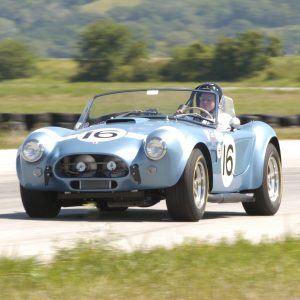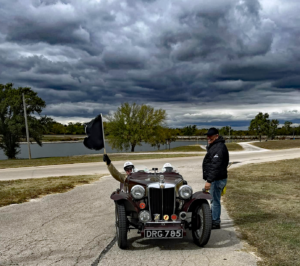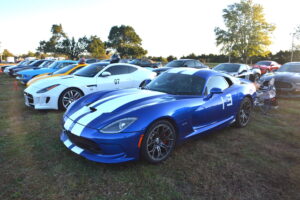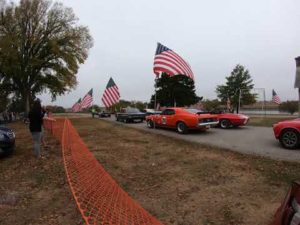by Jason Pendleton
Freedom, freedom, freedom” chanted the swelling crowd of young people that had converged on the courthouse square to voice its anger over the arrests of its peers by local police. Late into the night of July 6, 1963, the local police and sheriff’s authorities stood face to face with an angry mob of more than two thousand. Acutely aware that the situation was moving beyond their ability to control, the local authorities sought assistance from the state police and the governor. Highway patrolman and other law enforcement authorities from as far away as the state capital raced to the scene to help restore order.
The angry crowd did indeed move beyond chants of freedom and focused its energy on freeing its
cohorts from the local jail. With cherry bombs, cans, bottles, rocks, and bricks, aggressive members of the
mob bombarded the authorities who were protecting the building. Later the group stormed the jail to
free its arrested peers. To halt the assault on the jail the police fired tear gas into the crowd and authorized the fire department to spray the advancing demonstrators with fire hoses. Despite successfully
knocking down several assailants, the firemen yielded when other protesters seized the hoses and
slashed them into pieces. While the firefighters and police officers struggled with the protesters, they were “hit with beer cans, struck with explosive fireworks and pummeled with bare hands.” Flying objects struck two of the firefighters in the head, splitting their scalps and covering their faces with blood. Near the scene a protester hurled a full can of beer at the face of a young female onlooker, leaving her “disfigured.”2 Informed of the violence, the governor deployed members of the national guard, who descended on the town with loaded rifles and fixed bayonets. The presence of the national guard, combined with the waning effects of alcohol, slowly brought the violent demonstration to a halt. By dawn the police had restored order, but not before twenty-nine people were arrested, nearly one hundred were injured, and a police
captain had died during the violent clash.3

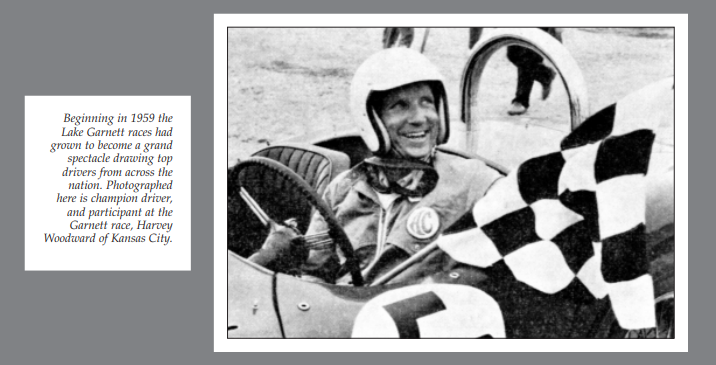
Captain Robert Cowdin’s death did not happen in Birmingham, Watts, Detroit, or any other major city where violent protests and riots occurred during the tumultuous 1960s. Surprisingly, the local police captain died during the July 1963 violence that rocked the small town of Garnett, Kansas. Why did a violent riot occur in a small southeastern Kansas town located seventy miles from Kansas City and seemingly isolated from the major cultural movements of the decade? Historians of the 1960s, including Terry Anderson, Gregory Schneider, Dominick Cavallo, and Kenneth Heineman, as well as sociologist Rebecca Klatch, have ignored the localized events in rural communities such as Garnett. Instead, scholars have focused their attention on the more national political movements, including the Students for a Democratic Society, Young Americans for Freedom, civil rights, and free speech, many focusing on college campuses.4 While historians Robbie Lieberman and Rusty Monhollon both provide much needed examinations of the decade’s events in the Midwest, their separate research also has focused on universities and their local communities.5 This article examines the violence that occurred in Garnett, placing the ostensibly aberrant event into a broader social context while demonstrating that the changes of the 1960s generation were widespread and extended beyond colleges and universities into the heartland.
The story of the 1963 riot began well before the actual event. In 1959 the Lake Garnett Racing Association, in conjunction with the Sports Car Club of America (SCCA), organized and hosted the first races in Garnett. These proved to be a huge success among sports car enthusiasts and racers from across America. Attendance at these events steadily grew from twenty thousand in 1959 to an estimated seventy-five thousand in 1962. The Lake Garnett races became a grand spectacle that drew foreign dignitaries from Germany, France, England, and Italy, as well as Kansas politicians who hoped to use the attention to bolster their election bids.6 In 1962 the races grew in stature after the SCCA sanctioned the Lake Garnett Grand Prix as a championship event for the Kansas City region. As a result of the designation, skilled drivers from across the Midwest and as far away as Connecticut and California converged on Garnett to race on the 2.8-mile road course that circled Lake Garnett.7 Organizers of the 1963 event billed the races as a battle between the famed East Coast driver Don Yenko and his Corvette team, and Carroll Shelby’s AC Cobra team from California. The anticipated battle helped draw more than fifty thousand fans from across the country.8
With a population of only three thousand people, Garnett lacked the necessary accommodations to handle the influx of thousands of overnight guests. Consequently, many visitors who arrived the evening of July 5 sought lodging in nearby cities including Ottawa, located twenty four miles north of Garnett. The people who flocked to Garnett included a significant number of college-age and high school youths. Many of the college-age visitors, which included a large contingent from Kansas and Missouri, established a campsite at South Lake in the evening hours of July 5. According to Gary Beauchamp, an employee of the Garnett water and power plant located at South Lake, “the entire park was covered with tents and blankets . . . [and] you couldn’t hardly find a piece of grass that wasn’t covered.”9
The campers at “tent city” began their “partying” the night of July 5 and continued into the early morning hours of July 6. One observer noted that “beer for breakfast” was the norm among those camped at the South Lake campsite. As Saturday, July 6, unfolded the intense heat combined with the oppressive seasonal humidity led many of the high school and college-age visitors to don bathing suits. A local resident observed that some of the bathing suits offered “considerable exposure.”10
Many of the young people spent Saturday consuming alcohol and viewing the trial runs at the Lake Garnett road course. Years later one man, a Garnett high school student in 1963, observed that “people were drinking and throwing beer and wine bottles on the race track throughout the day.”11 By mid-afternoon many of the streets and parks of Garnett were littered with empty cans and bottles. According to one observer, the streets had taken on a “beer-can decor.” Later in the afternoon of July 6, law enforcement authorities reported an increase of social disturbances among the college-age men and women. Police officers reported incidents of “heavy necking . . . sometimes in groups, girls seen pulling off hose and panties, while others [were] sunbathing and playing in bras and pants, and one lass [was] seen in scanty attire being pawed by several playmates.” One female resident “complained [to the police] of a male youth making [sexual] advances toward her.” The former Garnett high schooler described the scene at the South Lake as “an early Woodstock. . . . If you were old enough, you could do whatever you wanted. It was like an open bar.”12

As the late afternoon faded into the midsummer night, milling cars and people packed the streets of Garnett, including thousands of revelry-seeking young people. Many converged on the town square where two of the city’s taverns, the Brown Jug and the Spot, were located on the south side of Fifth Street.13 Richard Sallman, a twenty-year-old college student from Washburn University in Topeka, went downtown with his fiancé and college friends seeking “fun, drink, and a good time.” While Sallman and his group were inside the downtown bars, the streets surrounding the town square were packed with people in cars enjoying a “typical ride around.” Garnett resident Robert McIntosh noted that the “crowd was so thick I couldn’t hardly drive my brand-new 1963 Pontiac around the square.”14
By 10:00 P.M. the young adults had filled the local taverns to capacity. The proprietors of the Spot and the Brown Jug, unable to accommodate the massive throng of people standing outside, sold beer to go for six dollars a case. The town square, also the location of the courthouse and the jail, was the scene of a loud boisterous party with an estimated fifteen-hundred people participating in the merriment. Gary Showalter, who was present in the square that night, described the scene as “spring break meets Mardi Gras and one hell of a party.” The number of individuals in the square increased when two area bars (one in Scipio eight miles north of Garnett, the other in Welda nine miles south of town) both closed around 10:30 P.M., sending more youths toward the town square.15
At approximately 10:45 P.M., according to Tom Welsh, owner of the Spot tavern, Sam Geer, chief of the Garnett police, came into the bar and asked Welsh to close down because of the problems associated with the growing crowd in the square. When the chief left, Welsh walked next door to discuss the requested closing with John Brummel, owner of the Brown Jug. Having experienced no trouble with the patrons, the owners decided to remain open until their normal closing times. In fact, Welsh claimed “we were having a good time,” and the “people inside were pretty nice college age kids.” At 11:00 P.M. Chief Geer returned and, according to Welsh, yelled, “I said shut the God damn thing down now.”16 This time Welsh and Brummel complied.
According to Richard Sallman, the early closing of the taverns “interrupted a good time [and] forced hundreds . . . [more] students into the square.” Welsh added that Geer’s actions pushed two hundred angry people into the square who were content before and actually “put fuel on . . . [Geer’s] fire.”17 Closing the bars upset some people who responded by “lying down in the city streets, and blocking traffic.” Some of them were “dragged from their proneness by officers” and arrested. One anonymous youth yelled “the niggers do it, why can’t we!,” an obvious reference to the civil rights efforts in the South that received heightened media coverage throughout the summer, while others expressed their frustration by throwing beers and fireworks into the air and chanting “freedom, freedom.”18
The Kansas City Star reported that at 11:30 P.M. “Cherry bombs began to explode around . . . four Kansas State highway patrolmen, five Garnett officers and two Civil Defense patrolman [sic].” Some individuals began yelling obscenities and others threw more cherry bombs in the direction of the authorities. The police pursued and apprehended one of the antagonists in the “alley behind the Brown Jug” on Fifth Street. The white-shirt-clad youth tried to fight off the two policemen and yelled to onlookers “get these [expletives]. . . . Get ‘em! Get ‘em please! They can’t do this to me!”19
Other incidents involving intoxicated young people and the police took place throughout the square. Robert
McIntosh witnessed a “topless girl dancing on top of a car hood” and the police unsuccessfully attempting to stop her. Nearby one inebriated antagonist successfully eluded the police for “two to three minutes” to the delight of the college-age youths who voiced their collective disappointment upon his arrest. Some in the crowd, including Richard Sallman, reacted to the arrest and tossed their halfemptied beer cans toward the arresting officers. Two highway patrolmen witnessed Sallman’s actions and quickly arrested him and forced him into the jail located on the east side of the town square. The arrest of Sallman and others angered some individuals who reacted by verbally confronting the officers.20
By 11:40 P.M. the mood of the crowd had changed dramatically. While some people launched hundreds of beer cans and bottles toward the police, others aggressively interfered with police efforts to arrest their peers. Angered and upset by what they perceived as the overzealous actions of the police, some people stormed the small twostory brick jail but were “repulsed yards from the door.”21 Recognizing that the situation was out of control, the local police called the highway patrol headquarters in Topeka, as well as the Franklin County Sheriff’s Department to request more officers and tear gas. Simultaneously, the mayor of Garnett, Gwinn Shell, called Kansas governor John Anderson and pleaded for him to authorize the deployment of the national guard. The governor informed Mayor Shell that at that time he could not authorize the national guard to be used to keep the peace.22
Desperate to force the crowd to disperse, the local police called the Garnett fire department, which arrived at midnight at the southwest corner of the square at Fifth and Oak. The arrival of the fire department aggravated the “demonstrators [who] rushed them, wrested the hoses from their control and began slashing the hoses with knives.” During this battle protesters hit the firemen and police with a barrage of beer cans and fireworks. Nevertheless, firemen were able to connect one remaining hose and use it to keep the demonstrators from re-advancing, but failed in their efforts to force the rioters to leave the square.23

Around 12:30 A.M. the first wave of reinforcement officers arrived from nearby cities. Included in this group was Robert Cowdin, a police captain from Ottawa. Cowdin, equipped with tear gas, fired it into the crowd with mixed success. While the gas drove some people from the scene, the wind pushed some of the fumes back toward Cowdin. At this point Cowdin reportedly slumped over in the square and complained to other officers he could not catch his breath. His condition deteriorated and officers rushed him to the Anderson County Hospital.24.
About 1:00 A.M. the crowd began new chants of “freedom,” which Sallman recalled could be heard inside the jail. The rioters, motivated by their peers who were yelling from inside the jail, again attempted to storm the building but were halted by the police.25 Soon thereafter additional officers, requested by Governor Anderson, arrived from towns throughout eastern Kansas, and national guardsmen from Garnett and Ottawa were on the scene with loaded rifles and fixed bayonets to quickly establish positions protecting the jail. The additional police and the presence of the armed national guard calmed the crowd considerably. Some people continued to linger in the square while others began to leave. At approximately 1:30 A.M. officers spread the news that Robert Cowdin had died of a heart attack. The somber news quieted the remaining crowd considerably and marked the end of the rioting in Garnett.26
The Garnett authorities were ill-prepared for the huge crowd that gathered in the city square on night of
July 6, 1963. The initial violence of a few individuals rapidly spread to other members of the crowd and resulted in a two-hour melee that left Robert Cowdin dead and Kansas citizens searching for an explanation of the causes of the riot.
On the surface the most basic cause of the riot can be attributed to the young people’s massive consumption of alcohol. According to race attendee Bill Alexander, “beer was available absolutely everywhere in Garnett.” Different newspaper accounts of the event estimated that between eight thousand and twenty-one thousand beers were sold on Saturday, July 6, alone. That fact led Garnett officials to conclude that “drinking was the main cause of the riot.”27 Yet inebriated young people alone do not explain the wantonly destructive behavior or the flagrant and even violent disregard for authority in Garnett. The importance of the Garnett riot lies not in the nuances of the actual event but in the influence of broader cultural movements prevailing in the United States. The Garnett riot raises questions about why these high school and college-age youths acted with an apparent disregard for the rules and authorities.

In the wake of the events in Garnett, people throughout the state reflected on the incident and the participants’ possible motivation. The editorial staff of the Topeka Daily Capital questioned how the riot could happen in “clean cut America?” They offered the opinion that “It was blatant disrespect for law and order and an effort of the offenders to take the law into their own hands.” The editorial staff of the Kansas City Star stated, “The riot . . . was another pathetic example of the fringe group of youth who, for no rational reason, destroy a good thing for themselves and everybody else.”28 The Lawrence Daily Journal World’s editors also blamed the events on the young people of the day:
the misdirected beatniks, showoffs, lardtails, meat- balls and non-conformists who follow the noisy ma- chines are a lousy lot who are almost certain to get on the national news wires. Somehow the punk who goes around half-naked and who likes his liquor in public is highly susceptible to mob psychology. And he isn’t the poor youngster from across the tracks who never had a chance as much as he is some boy from the “right” part of town who has the benefit of a fat allowance from pop and perhaps is half-way through a college education.29
College students, desperately earnest students, have been rioting of late in capitals throughout the world. Rioting for causes, some of them good, as though some contagion of violent fervor were spreading over national boundaries. But the Garnett riot had no cause—however provoked it might have been—beyond a perverse pleasure of violence for the participants: hedonism running rampant, irresponsible animal self-indulgence discrediting their generation.30
Attempts by local and state officials, as well as newspaper editors, to place the onus for the events in Garnett entirely on the youths and their upbringing were based on the premise that something was wrong with America and that the actions of the people in Garnett demonstrated that. Historian Alonzo Hamby has written that the economic prosperity following World War II drastically altered the formative years of college-age individuals in the 1960s. Hamby argued that “The American character . . . [was] unmistakably altered . . . by a prosperity dependent on mass consumption.”31 Similarly, sociologist David Riesman focused on the transformation of American morality, positing that before World War II the majority of Americans possessed an “inner directed” sense of morality resulting from people growing up in an early twentieth-century “industrializing economy and a psychology of scarcity. It had extolled hard work, saving and individual gains as the primary virtues.” Where the prewar character of most Americans was self-regulated, the new postwar character was influenced by outside factors. Hamby added that the new “outer directed man was motivated by an ethic and consumption and cooperation; his values were less deeply held and he was likely to take his cues to proper behavior not from any instilled morality but from the expectations of those around him.”32
The postwar era of consumption created a generation of young people in the sixties with a new mind set. Unlike their parents who grew up in the scarcity-driven prewar era, historian Todd Gitlin contends that “the children of . . . [the] middle class . . . were raised to take affluence for granted.” According to historian John McWilliams, the parents of the 1960s generation had “more disposable income than previous generations . . . [and] could finally afford the American dream: marriage, children, automobiles, televisions, and homes in the suburbs. The depression generation wanted its children to have a better and easier life than it had.”33 The 1960s generation experienced its parents’ indulgence in consumer goods and their focus on leisure activities. Their secular upbringing instilled in them a belief in the importance of gratification in life. Pursuing anything one desired—as apart from what one needed—became the norm for much of society in the late 1940s and early 1950s. America’s booming postwar economy made that pursuit possible. Americans in the postwar era moved beyond buying simple necessities and instead sought items and activities that provided more material gratification. Consequently, Hamby argues, “the ‘other-directed’ culture of consumption and leisure encouraged wide and immediate gratification . . . and result[ed] . . . in the development of a mood of liberation which permitted the discussion and display of previously taboo behavior and led to a breakdown of the sanctions against it.” Sociologist Daniel Bell similarly argued that “American capitalism . . . [had] lost its traditional legitimacy, which was based on a moral system of reward rooted in the Protestant sanctification of work. . . [and] substituted a hedonism which promise[d] material ease and luxury, yet shie[d] away from all the historic implications of a ‘voluptary system’ with all its social permissiveness and libertinism.”34
As the 1960s generation matured from young children to adolescence, it experienced a society unlike any before in American history. The college-age youths of the early 1960s took the lived experiences offered by their parents and expanded their legacy to include a pursuit of pleasure through recreational activities. The Garnett riot, with its foundation in a daylong beer binge, reflected the young peoples’ expanded pursuit of gratification. According to historian Todd Gitlin:
the adolescent society depended on affluence — on time and money of its own to spend—but it also flirted with the harmless part of the culture of delinquency: the spirit of fun and adventure, the disdain for studies, the drinking, smoking, making out, swearing, staying out late. Never before had so many of the leisured young had a chance to spend so much so relentlessly to indulge their tastes.35
Americans as a whole, however, were still oblivious to the postwar hedonism among the youth of the 1960s and its concomitant ideological shift. The Garnett police department’s lack of preparedness for the young persons’ violent reactions reflected the ignorance of the majority of society with regard to the changes embedded in American youth. From their previous four years of experience, local authorities typically expected a large crowd at the races. The organizers in 1963 expected a large crowd again. Despite the absence of large-scale problems before 1963, Garnett’s mayor Gwinn Shell reportedly sought the use of the national guard because it had been on duty each year since the races began in 1959. Major General Joe Nickell of the Kansas National Guard informed Mayor Shell that he could not authorize the guard to be used by Garnett officials in a “preventive capacity” in 1963.36

Ultimately the law enforcement authorities in Garnett did not drastically change how they planned to deal with the huge throng of people that flocked to Garnett. In 1963 the local police and the Anderson County Sheriff’s Department received assistance from the Kansas Highway Patrol, as well as additional officers from Olathe and a Civil Air Patrol unit. The local officials were confident that they could adequately handle the massive influx of visitors because previous crowds at the races generally had maintained respect for authority and exhibited self-control. Additionally, Sheriff Bill Gadelman stated, “the city fathers didn’t want too much law enforcement as they were afraid it would chase away business.”37
The local law enforcement authorities’ attitudes, actions, and decisions on July 8–9, 1963, played a critical role in the rioting that erupted in Garnett. Although many editorials placed the blame on the young people, others (including those who participated in or witnessed the event) argued the police were responsible for igniting the turmoil. According to Richard Sallman, the police bore some responsibility for their decision to close the bars early, forcing hundreds more inebriated people into the square. Tom Welsh, owner of the Spot Tavern, stated that he warned the police chief that early closing would only upset the young people. Welsh added that “closing early really got things going in the square.” Robert McIntosh similarly stated that if the police had let the “students” drink until regular hours they eventually would have left the square. In a letter to the editor in the Summer Session Kansan, published a week after the riot, Ellis Couch asked, “Was it a wise idea to close the taverns early when law enforcement strength was low?”38
The police decision to close the bars bordering the town square coincided with their increased efforts to force the crowd to disperse. According to Sallman, the police were overzealous in their attempts to stop something that was not yet out of control. Sallman, despite being arrested and later pleading guilty to disturbing the peace, contended, “they did not have enough police to handle [it] . . . so we took advantage of the situation.” Robert McIntosh stated that the “lack of [police] personnel” combined with officers “overreacting to every little thing” led to increased tension among those present. Bill Alexander added that there simply were “not enough police and they did not know how to handle the crowd.”39 The insufficient number of officers and the actions of those officers present in Garnett reflected the absence of any detailed plan for dealing with a large, unruly group.
According to sociologist Gary Marx, a lack of police organization that results in the absence of a clear strategy may hasten rather than stop confrontational situations. Clearly, the authorities’ efforts to calm the situation by arresting people who were noncompliant raised the intensity level of many of the youths. The officers attempted to diffuse the situation by becoming more assertive and aggressive in the efforts. Their aggression ultimately contributed to the escalation of violence. According to sociologist Rodney Stark, the confrontational actions of the police to force crowds to disperse often provoked riots in the 1960s.40 Some Garnett rioters would agree; they believe the police were overly aggressive, that some had “chips on their shoulders,” and had in fact “provoked the riot by their actions.” One also complained that the police used excessive force, and according to Sallman, the officers’ aggressive actions “pushed us into the crowd mentality.”41
As the fun-seeking young people turned into an angry mob, the key police action that fully ignited them was the decision to call out the Garnett Fire Department and authorize the use of hoses. According to Bill Schul, “Instead of controlling the situation . . . [the use of hoses] served only to incite the crowd.” The Topeka Daily Capital’s account of the incident claimed that the rioting started after the fire department arrived and the firemen began to set up its hoses. Similarly Garnett resident Phil Handy, who witnessed the fire department’s actions from fewer than fifty feet away, stated, “when they started cutting fire hoses that’s when my friends and I backed way off to observe . . . as it was really getting out of hand.”42 Why the police decided to use fire hoses in the first place remains unclear. It is plausible, however, that they were motivated by the events that occurred in May 1963 in Birmingham, Alabama, when Birmingham public safety commissioner Eugene “Bull” Connor authorized the use of fire hoses on black students who marched passively to end segregation.43
The Garnett riot reveals that the state’s law enforcement officials did not yet understand how to handle in-
stances of civil unrest. Seemingly safe in the heartland, Kansas officials likely viewed the protests of the early 1960s as unique situations involving African Americans in the South and liberal college students in the East. According to Anderson County Attorney Wayne Loughridge, “There was . . . a general feeling in town that it . . . couldn’t happen here.” The Garnett authorities’ naivety about the potential for violence was evident by their lack of preparation and training. After the riot Garnett Police Chief Sam Geer echoed those sentiments: “We are not trained in this kind of work, and of course, have not had the experience with it as they have had in other parts in the country.” Anderson County Sheriff Bill Gadelman added, “We, as with other officers are in great need of more training in the handling of mob situations.” The outbreak of rioting and the inability of the law enforcement authorities to handle it forced Kansas officers to recognize the need to upgrade their skills and to handle instances of protest more professionally. An official study of the Garnett riot reported the consensus opinion of the director of the Kansas Bureau of Investigation (KBI), the superintendent of the Kansas Highway Patrol, and the commander of the Kansas National Guard that “measures . . . be taken to better prepare Kansas communities in crowd control, and prevention and control of riots.”44

The state followed these recommendations, and in 1964 the Kansas Highway Patrol and the KBI provided instruc- tions to law enforcement officers across the state, utilizing techniques and strategies learned from the Kansas City, Missouri, Police Department and the United States Marine Corps. Instructors held two-day schools at regional sites across the state and focused exclusively on handling crowds and riot control. More than six hundred law en- forcement officers participated in the training program, in- cluding sixteen from Garnett. The instructors divided the schools into two parts. The first included lectures on how to handle a baton and offered understanding of mob psy- chology. The second part involved practical drills such as signals and basic riot control formations. Instructors con- sistently used the Garnett incident as a teaching aid, em- phasizing what the officers on hand could have done dif- ferently. The Governmental Research Center of the University of Kansas conducted a report on the training schools and stated that the “need for this type of training was pointed up by the riot which occurred at the Lake Gar- nett Sports Car races in July of 1963.”45
When the races returned to Garnett in July 1964 the local authorities were better prepared to handle the crowds that came to town. Learning from their mistakes of the previous year, authorities began planning for additional law enforcement assistance as early as January. In May the Lake Garnett Racing Association appropriated twenty-five hundred dollars to “procure a trained and experienced police force to be on duty at all times during the two days of racing.”46 The organizers made no such appropriation in 1963. Their efforts in 1964 resulted in the presence of approximately one hundred additional officers and thirty national guardsmen stationed in Garnett. A month before the races the authorities had organized and prepared for the possibility of crowds and trouble. The police, bolstered by more than one hundred men with seven police dogs and equipped with the knowledge they had learned at the Crowd and Riot Control Schools, were intent on preventing a riot from erupting in 1964.47
The authorities in Garnett took specific steps to prevent a repeat of the 1963 riot. They recognized the town square traditionally had been a gathering point for youths in Garnett, and in 1964 closed the square and set up a traffic detour a block away. In addition to the increased police presence, the City of Garnett, in cooperation with the Lake Garnett Racing Association, arranged for a free baseball game, go-cart racing, and a dance at the Warner Garment Factory in an attempt to provide entertainment for the mass of young people. Mayor Shell was so convinced the added officers and activities planned for the young visitors would prevent a repeat of the rioting that he declared: “There simply will be no riot in Garnett this year.”4
In 1964 thousands of young people again arrived in Garnett for the races. Many of them had been present the year before. Some returned seeking to participate in similar revelry while others reportedly came to repeat the violence of 1963. The police decision to close the town square pushed many individuals to the dance at the Warner factory. Outside the dance a crowd of one thousand people gathered early in the evening. Although the bulk of the crowd was peaceful, some young men “either unable to enter the dance or unwilling to pay the admittance charge” became verbally abusive and aggressive toward the police. At 8:45 P.M. the officers called for reinforcements. While some people launched fireworks at the officers, another group attempted a “flying [human] wedge” into a line of police. With the assistance of trained dogs, police maintained control and prevented widespread violence from erupting.49
At South Lake, which again was the site of a large group of college-age campers, the mass of young people enjoyed themselves around a large bonfire where they drank, sang, and shot fireworks. According to Gary Beauchamp, who was on duty at the power plant that evening, the majority of the “kids” were partying and having a good time. Around 1:00 A.M., recalled Beauchamp, “About fifteen to twenty really aggressive youths began shouting ‘we want the power plant,’” and advanced with designs on taking control of the plant. They quickly changed their minds, however, when the police officer who was stationed there released his police dog, forcing them to flee. Other officers quickly swarmed in and arrested three individuals and forced the others to extinguish the bonfire. The threat of violence in Garnett was thus ended in the early morning hours of July 5.50
The Garnett authorities had taken positive steps in 1964, but when comparing the number arrested that year with those in 1963 it appears the 1964 events were worse. Despite the fact that seventeen more people were arrested in 1964 than the year before, the two events differed dramatically. In 1964 no officers were injured, no tear gas was used, the governor did not deploy the national guard, and only a handful of people, including two who were “nipped” by police dogs, received injuries.51 Despite the lack of widespread violence and property damage, the next day some newspapers throughout the state claimed that rioting had erupted again. The Kansas City Star front page headline read, “Riots, A Crash At Grand Prix.” Despite the headline, the article did not provide an account of the violence on page one. In fact, the synopsis of the event claimed that the “ruckus was carried out to the music of the Fabulous Continentals. . . . And in the lulls between charges [toward the police] the rioters also danced the twist with girls who accompanied them.” The content of the article reveals incidents of violence, but all attempts to call the events of 1964 a riot were farfetched. One anonymous individual commented: “I didn’t know I’d been in a riot until I read the morning papers.” The Kansas City Times headline blared “Garnett Fails to Stem Riots” and provided false information about the youths’ attempt to storm the power plant. According to the article, a “20-year-old Kansas State university student . . . was spotted inside the plant with his hand near the vacuum pump valve on the boiler. If the valve had been shut . . . the boiler probably would have exploded within minutes blacking out this city of 3,000 and shutting off the water.” Gary Beauchamp, who was on duty inside the plant at the time, took offense at the story and adamantly asserted that it was incorrect. The Garnett Review headline that read “Throng to Annual Races; Disturbances Held in Check” more accurately portrayed the events of 1964.52 While some young people were drunk and shouted obscenities, and others exhibited violence by throwing beer cans and fireworks, the violence neither was out of hand nor resulted in rioting. The media, however, ignored the obvious differences from the previous year and widely commented on the participants’ unruly actions.
Most commentators focused their blame on the young people and the “social climate of the times.” Judith F. Taggart in the Lawrence Outlook commented: “We don’t know the whole answer. We do know that the fault lies not with the law enforcement agencies, but with kids, and the parents of those kids, and the society of which they are apart.” The editorial staff of the Topeka Daily Capital stated, “Somewhere there has been a failure in the upbringing of youth when our national holiday is observed by rioting young people. . . . Does it add up to too much money, too many cars, too much indulgence and too little responsibility on the part of parents?”53

The comments and questions raised by editorials in the wake of the 1964 event show that despite the experi- ence of 1963, many people at the time again were surprised by the actions of the young people in Garnett. Fortunately, the local authorities in Garnett, who according to Gary Showalter had looked like “Andy Griffith meets Keystone cops” in 1963, had learned from their experience and taken significant steps to prevent rioting from erupting again.54 The presence of additional law enforcement clearly played a significant role in stemming the violence. Equally impor- tant, however, were the decisions and the actions taken by the police to avoid any chance for a repeat of the rioting.
In 1963 the police reportedly attempted to arrest individuals committing even minor crimes. Many protestors felt the arrests were unjust and led to an increase in hostility. In 1964 the Garnett authorities made a conscious decision to focus on larger issues and avoid instigating the crowd. Two days before the races in 1964 Police Chief Sam Geer stated, “Municipal ordinances against drinking of malt beverages in public and littering will be enforced on a discretionary basis.” The decision reflected a new understanding that police actions potentially inflame situations involving large crowds. Along the same theme, Garnett City Manager Howard Rubin stressed that the city fire department would not be used for crowd control in 1964.55 The authorities’ advanced decision to announce that they would not use fire hoses was a tacit admission on their part that the fire trucks had in fact contributed to the violence the year before.

Despite the prevention of rioting in 1964, the Lake Garnett Racing Association (LGRA), in conjunction with Garnett city officials, decided to discontinue the races. According to LGRA board member Jim Sobba, the increases of local opposition and the rising costs associated with hosting the races were key factors in the decision. Another important issue that also prompted Garnett officials’ decision to discontinue the races was the realization that the young revelers would return in 1965 and violence might erupt again. The SCCA Lake Garnett races, established in 1958, had been a by-product of the postwar affluence and Americans’ increased focus on entertainment and leisure. Racing expensive sports cars such as Maseratis, Austin-Healeys, Jaguars, Alfa-Romeos, Sunbeams, Corvettes, and others by the actual car owners reflected a significant amount of extra income and time available for leisure.56 Garnett officials successfully made their city an annual Fourth of July holiday weekend destination that resulted in an economic boost for the community. The success, however, drew thousands of young people to Garnett who unleashed their generation’s values of self-gratification, which caused an eruption of violence that ultimately led to the demise of the car races.
Despite being geographically situated in the center of America, Kansans by the early 1960s—as well as the rest of Americans — were connected to an emerging national culture. According to sociologist Daniel Bell, “in the quarter century after World War II, the United States . . . because of the revolution in communication and transportation, . . . became a national society—in the fundamental sense that changes taking place in one section of the society began to have an immediate and repercussive effect in all the others.”57 Similarly historian Beth Bailey contends that in the wake of World War II a national culture had emerged in America as a result of:
the nationalizing forces of the federal government, the market, consumer society, the mass media, and large institutions, both public and private under- mined the ability of local elites to control the bound- aries of their communities. The opportunities for mo- bility—both social and geographic—presented by a strong economy, by universal high school education and the explosion of attendance at colleges and universities, and by new legal protections of civil rights, changed the face of America. Radio, television, and Hollywood films offered people knowledge of a wider world, and that knowledge sometimes chal- lenged local beliefs and local hierarchies.58

The youths’ overindulgence in alcohol and their resul- tant violent reaction to police efforts to stop their revelry re- veals, in part, a generational attitude that had begun to re- ject conformity. Most immediately these representatives of the 1960s generation cast off their parents’ adherence to self-control and obedience to authority and were replacing those ideals with a commitment to self-expression, which they had experienced through the booming postwar econo- my. Historian David Farber argues that “hedonism at home . . .[was] not so easily turned off at the factory gates or the public school.” He added “a society that increasingly de- pended on selling an ideal of unrestrained pleasure . . . [had] difficulty defining the borders of responsible con- sumption, let alone inculcating an ethic of hard work, dis- cipline, and respectability. By 1960 some Americans, espe- cially the young were pondering the mixed cultural messages.”59.
Occurring a full three years before the commencement of the violent demonstrations against the Vietnam War, and devoid of the overt politicization of the Students for a Democratic Society, the Young Americans for Freedom, and the Civil Rights Movement, the Garnett riot demonstrates that the 1960s generation was immersed in self-indulgence, or “hedonism running rampant,” as the juvenile director of the attorney general’s office characterized the incident. This attitude permeated rural Kansas, entwined within the same culture of affluence that actuated students on college campuses across America during their self-proclaimed “era of protest.” Despite the link they had with the other protesters of their generation, the young adults in Garnett used the era of protest to their own advantage, merely proliferating their self-absorption rather than struggling for meaningful change in society, all under the aegis of the culture of resistance.

